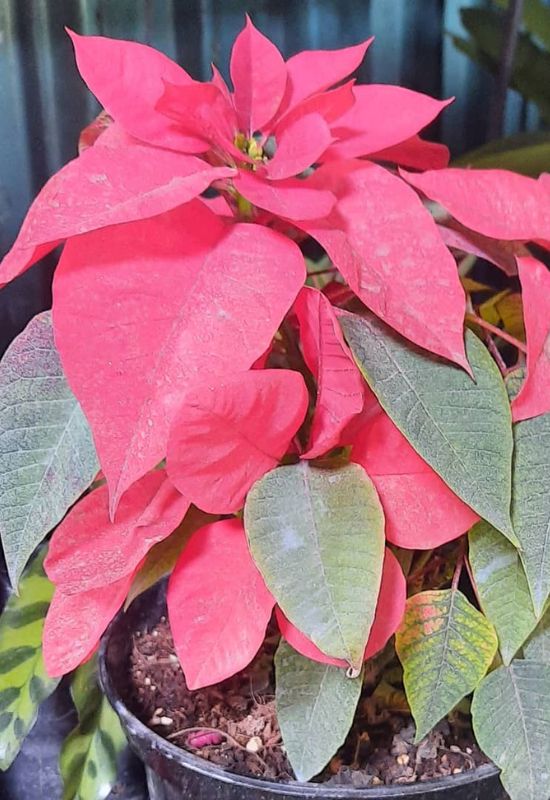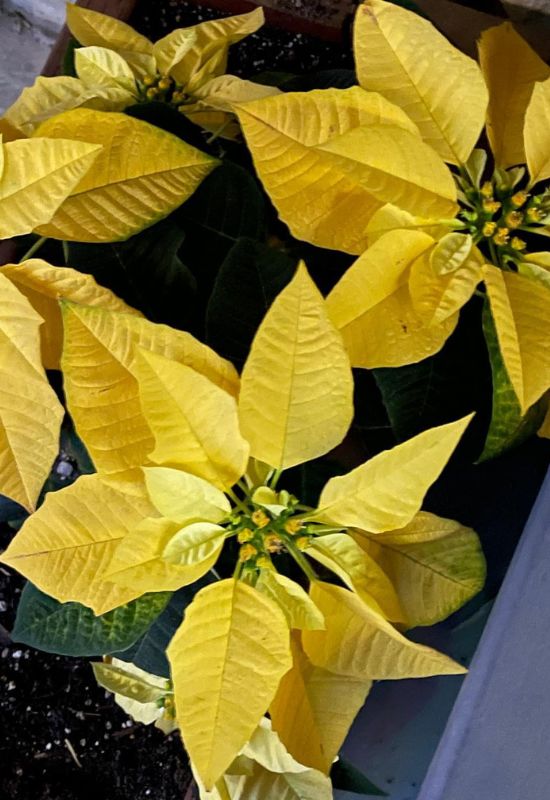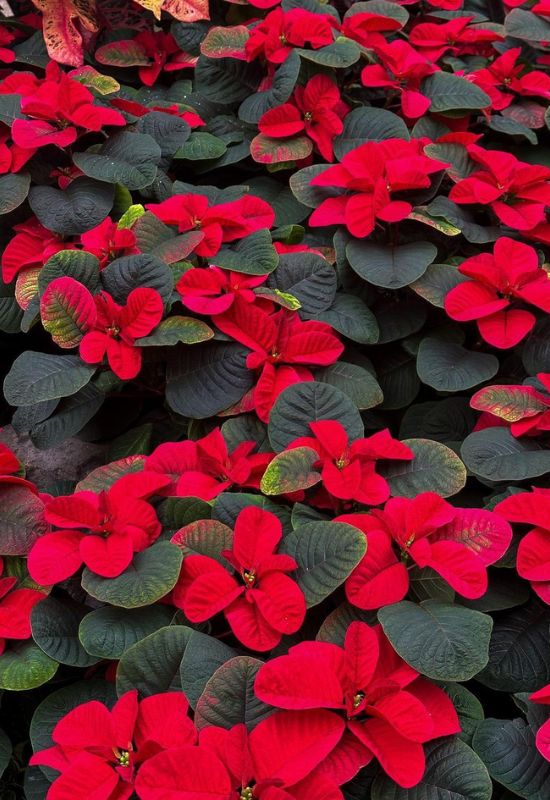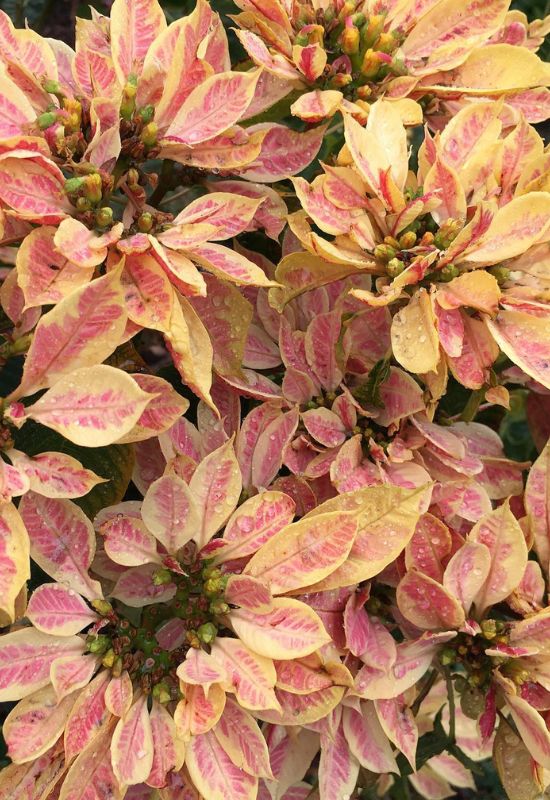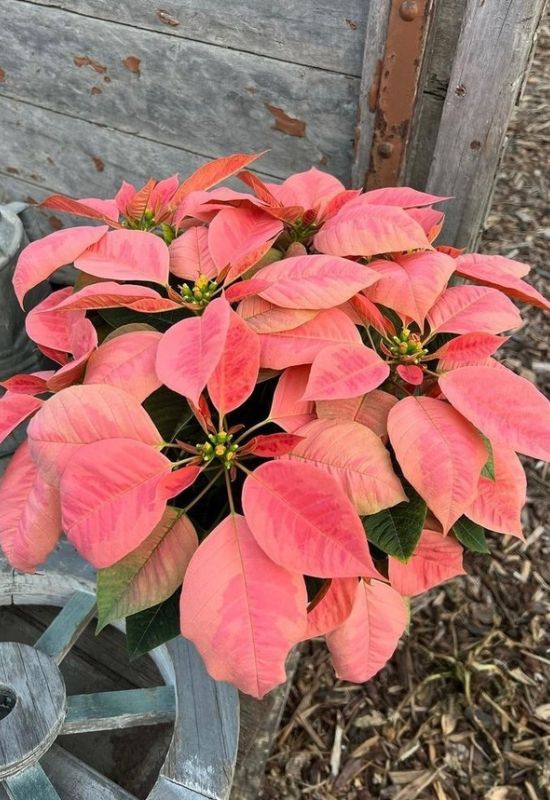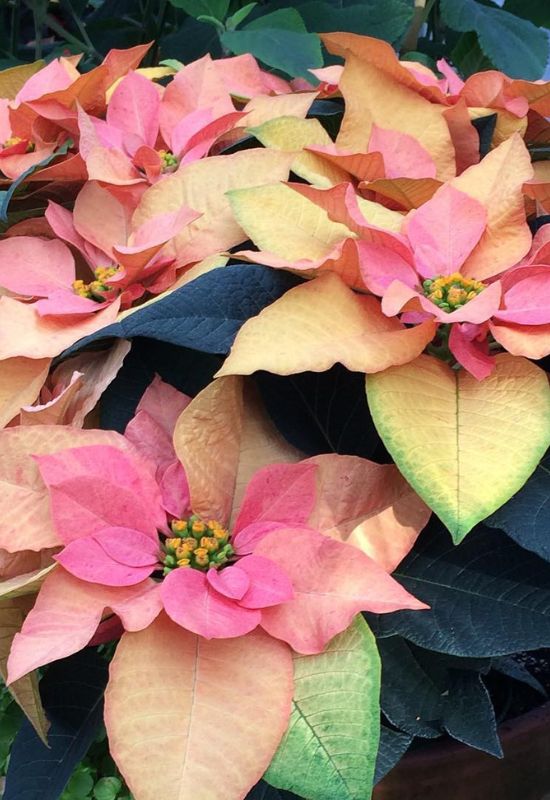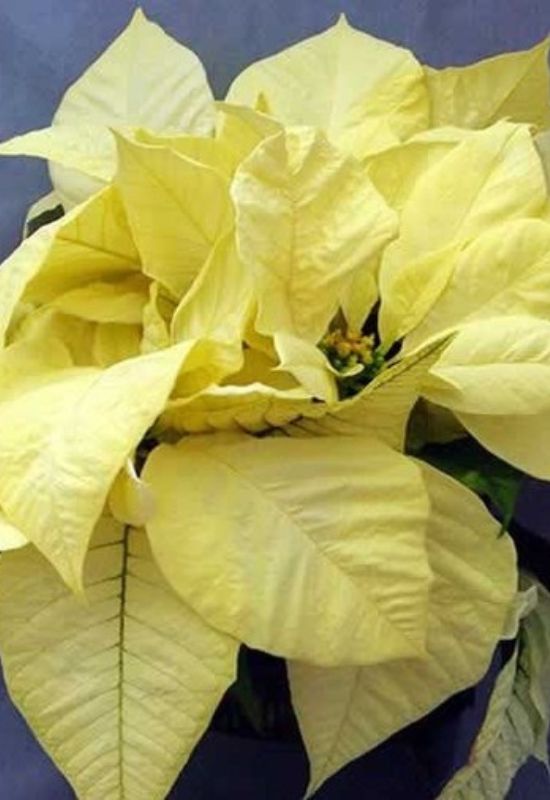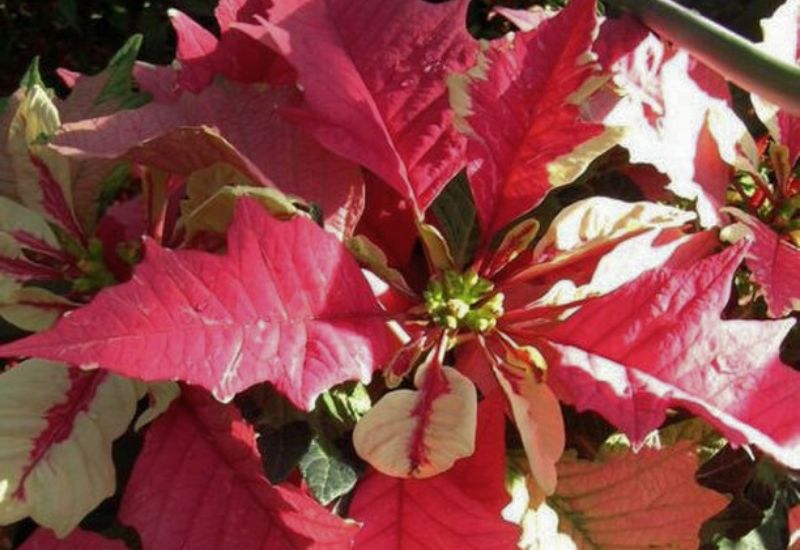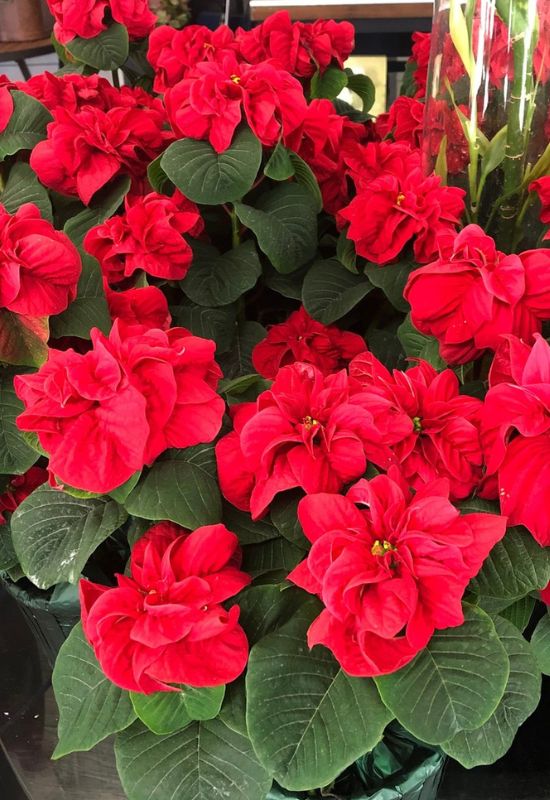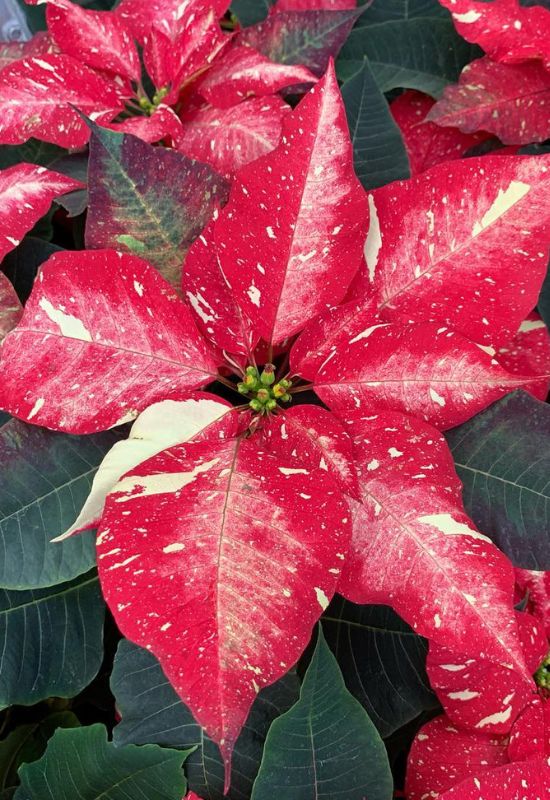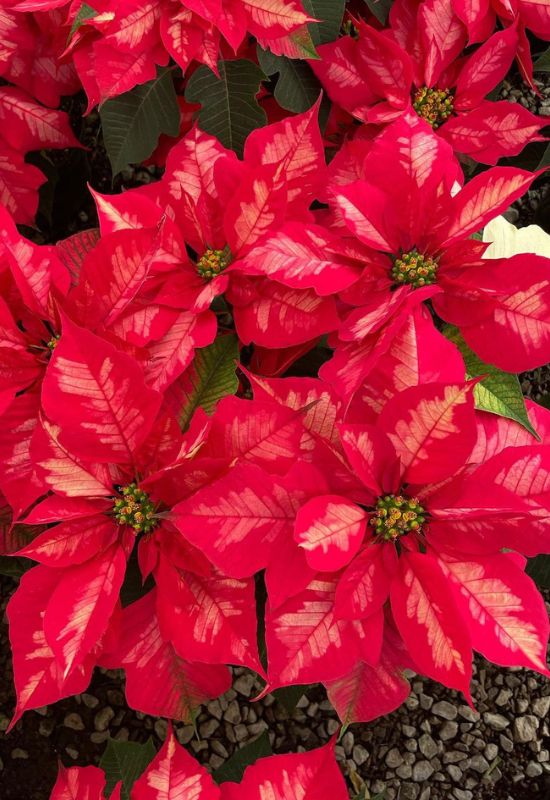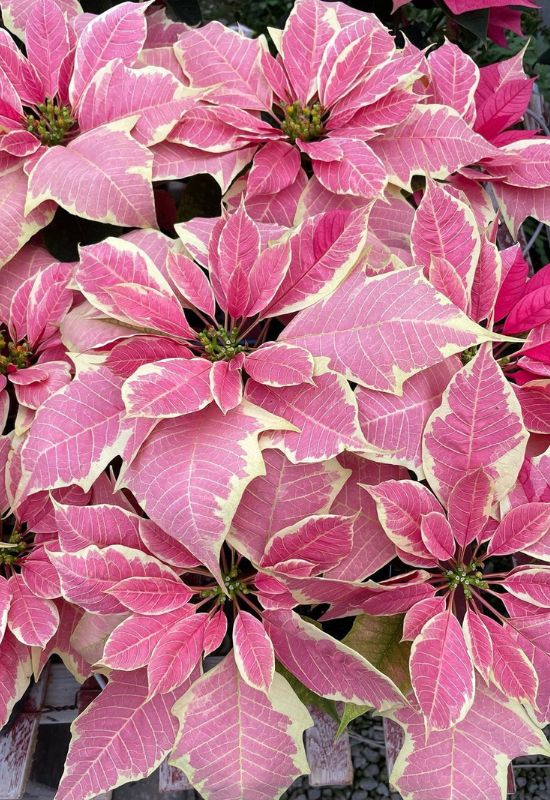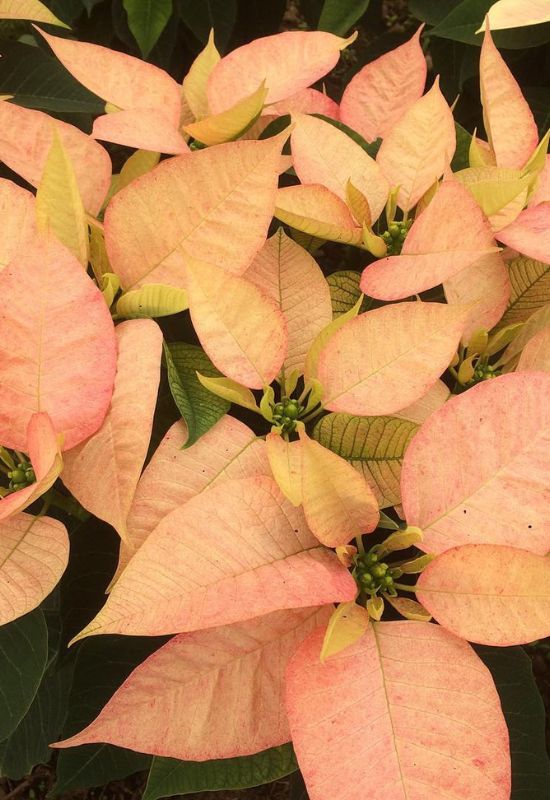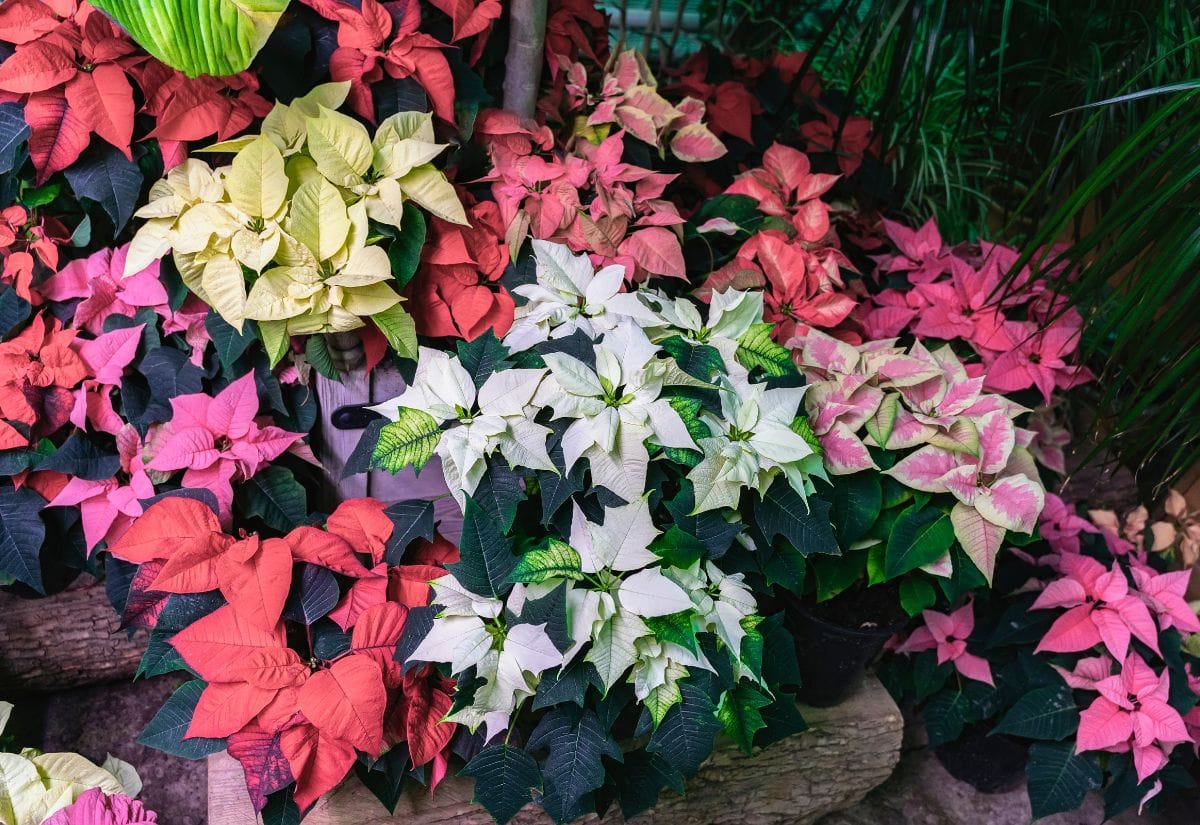
That big, fiery, festive and energetic splash of red at the top of poinsettias always draws attention, admiration and it asks a question… Why has this super popular Christmas houseplant got such colorful leaves?
They are actually bracts that accompany their oddly timed little winter blossoms. And in fact, we love it for its lush, broad and impressive foliage, and when the noel comes, stores and stalls dressed for yuletide fill with this exotic plant…
When poinsettia first became popular, scarlet was the shade we all saw and loved, as did the Aztecs, the first who ever grew poinsettias… But since then, breeders have come up with poinsettia cultivars with bracts in many colors, with pinks, with pinks, whites, cream and yellows, and variegated foliage as well.
And sometimes the leaves have changed shape, giving Euphoria pulcherrima (that’s how botanists call it) many personalities! And in fact, there are more than 100 poinsettias varieties to choose from!
More than 70 million are sold in a matter of only six weeks every year! So, let’s meet all the colors, all the faces, all the transformations of different types of poinsettias, but also remember that you can grow it outdoors as well in hot countries…
25 Colorful Poinsettia Varieties to Elevate Your winter Home Decor
The popularity of poinsettia means that new varieties are being introduced all the time. But there are some types of poinsettia colors and varieties that have become very popular, others that are just so colorful that we could not leave them out. And here they are:
You will see that poinsettia is more than a “Christmas houseplant” very soon, but first things first, shall we start from the beginning?
1: Poinsettia (Euphorbia pulcherrima)
Let’s start with the mother species, which was also the first to become popular, a classic! Native to Mexico and Central America, it is actually a small tree, and a special member of the vast Euphorbia genus, in fact, its “first name” is pulcherrima, which means “very beautiful” in Latin!
And so it is, growing to 13 feet tall in the wild (4.0 meters) and bringing its naturally but intensely bright scarlet bracts high up, to signal to pollinators that the small dark yellow and red flowers are now ready for a sweet meal…
Known to the science since 1834, but discovered in 1803, it is named after Joel Robert Poinsett, a US minister to Mexico, but it was introduced to the West by explores and naturalists Alexander von Humboldt and AiméBonpl and. It is, of course, the absolute “standard”, the prototype of all poinsettias, and it is also where our colorful story begins…
2: ‘Green Envy’ Poinsettia (Euphorbia pulcherrima ‘Green Envy’)
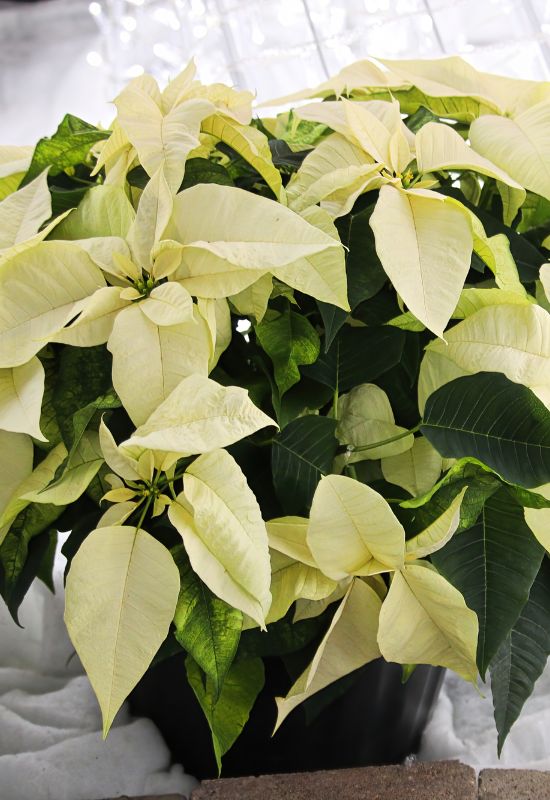
And now it is the festive time to start getting to know the colorful daughters of Euphoria pulcherrima, and we shall start with a very different cultivar: ‘Green Envy’.
This variety is also very suitable for the Christmas season, because it has three colors, and it offers us two, with a twist. In fact, the bracts are of a lunar shade of chartreuse, sometimes tending to whitish, and the little clusters of small yellow flowers in the middle adds an accent with their deep yellow.
But this nighttime effect is then heightened by the shady coloring of the other lush leaves… Yes, because they are of a dark tonality of green, which offer you an amazing but also very elegant contrast.
3: ‘Freedom Peppermint’ Poinsettia (Euphorbia pulcherrima ‘Freedom Peppermint’)
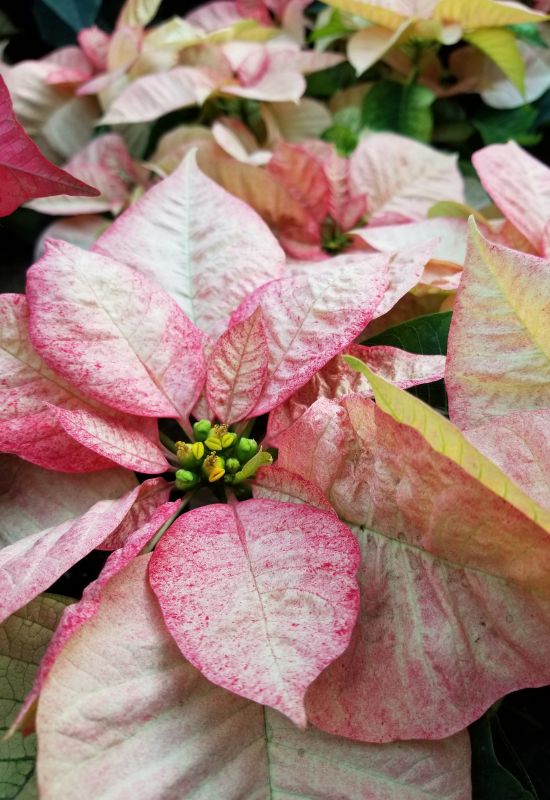
‘Freedom Peppermint’ is the romantic rebel of poinsettia cultivars! Yes, because it mixes very unusual qualities… To start with, the bracts can be so lush that they take up most of the plant itself, leaving little space to the dark green leaves at the base.
But what is exceptional about the modified foliage that accompanies a very small terminal cluster of tiny yellow flowers is another thing… They are… pink, mainly, but you fan actually expect shades from pale shell, to salmon, and then even coral and other rare tonalities.
This may possibly depend on the light it receives, but for sure, it is a variety with many personalities. As happens with this houseplant, you can also get hybrid leaves, that are partly green and partly pinkish and even white. It will certainly add an original touch to your living room or office though!
4: ‘Biancaneve White’ Poinsettia (Euphorbiapulcherrima ‘Biancaneve White’)
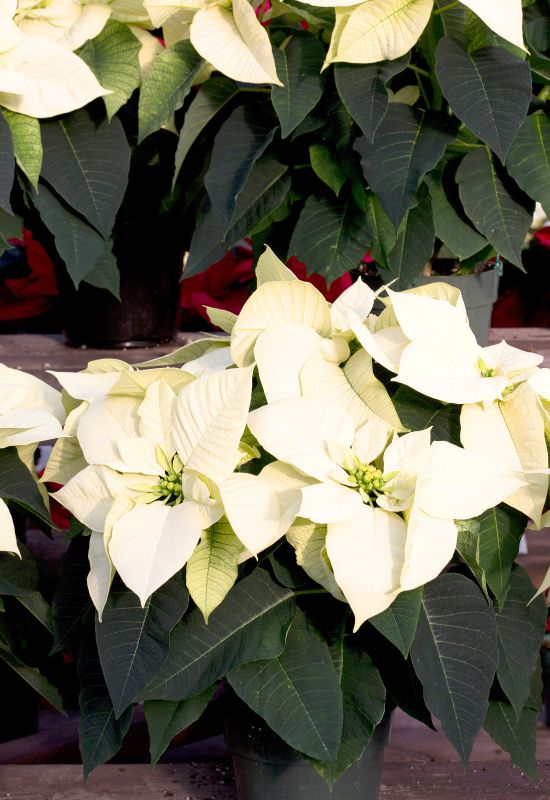
Guess what? “Biancaneve” is the name Italians give to fairy tale superstar Snow White, and this should give you a clue… But it also tells you that this poinsettia variety is really perfect to catch the full spirit (and color) of the winter season!
Yes, of course the bracts are fully, candid, immaculate, luminous white! In fact, it is the variety that has arguably the purest shade ever!
The modified leaves form a rosette at the top, leaving ample space for the dark hunter green lanceolate foliage to provide an excellent contrasting frame, or backdrop if you wish.
A small cultivar, it will avoid any tonality that it out of theme, and in fact, the little flowers at the top are pea green, and very few indeed. It certainly is a striking Euphoria pulcherrima, almost deserving the Latin title of “purissima” or “albissima”.
5: ‘Lemon Glow’ Poinsettia (Euphorbiapulcherrima ‘Lemon Glow’)
And we move on to a new transformation of Euphorbia pulcherrima: ‘Lemon Glow’ poinsettia! This time, our cultivar diverts from the Christmas theme altogether… In fact, it has a fruity and sunny personality instead!
The actual color you will most likely get, however, is not that of the Mediterranean citrus in its name… It is actually a moredelicate and rare melon, though it appears that it develops bracts of brighter and more intense tonalities of yellow in the right light…
Apart from the culinary confusion, this is a very energetic houseplant, and the modified leaves, mainly lanceolate at the top, can become really predominant, leaving just a “dark green foundation” of dark British racing green at the base… And green are the little blossoms too, but shamrock and on the glossy side!
6: ‘Country Quilt’ Poinsettia (Euphorbia pulcherrima ‘Country Quilt’)
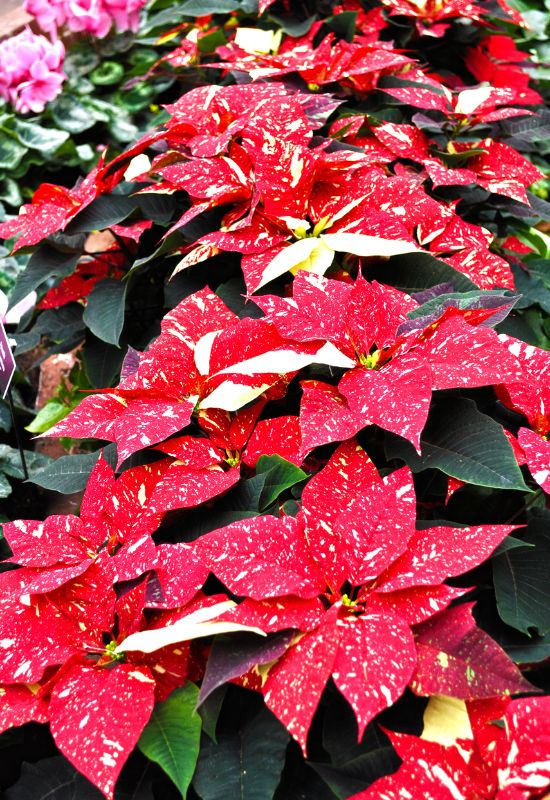
We remain in the realm of traditions, but this time we move away from the celebrations of yuletide and into rural traditions, with colorful ‘Country Quilt’!
The name comes from its very attractive and contrasting variegation, which this cultivar displays on a rosette of mainly lobed bracts at the top… There you will see a strong, bright, energetic and vibrant magenta, which fills rooms and offices with light and luxury… But look closely and you will see spots of ivory to cream white, which, sometimes, spread into larger patches.
The irregular patterns they create add a dynamic dimension to this variety, while the greenish yellow flowers in the middle add a delicate touch. Dark and moody, the base foliage can take on purplish overtones, adding depth to the ensemble.
7: ‘Christmas Mouse’ Poinsettias (Euphorbia pulcherrima ‘Christmas Mouse’)
And we are pleased to introduce to you two recent children of mother Euphorbia pulcherrima, sweet twins of the ‘Christmas Mouse’ series! And quite original they are indeed!
In fact, you may even have doubts that they are really poinsettias at all… And do you know why? Their leaves are ovate, rounded and broad, with no tips and a velvet like texture, clear veins and ribs n relief!
This applies to the bracts as well, which, of course, form a lovely and soft looking rosette at the top. And you can choose between two colorful babies…
One is bright and intense scarlet red (though sometimes it leans on the crimson side), while her sister is full pink, though sometimes she blushes to rose tonalities.
And the little bright green flowers in the middle just look like small pearls to decorate these newcomers to the family! The foliage is dark green, on the pine side, sometimes with purplish overtones.
8: ‘Enduring Marble’ Poinsettia (Euphorbia pulcherrima ‘Enduring Marble’)
If you like variegation but you are also looking for elegant and even refined colors, then you will love the ‘Enduring Marble’ variety of poinsettia! The bracts display an irregular splash of pink in the middle, which follows the mid rib with a wavy fishbone pattern.
But this variety also responds to light conditions, so, this central plume can range from pale, even sand, to salmon (quite common) and peach, and then even blush to hints of rose…
All around it there is a yellow halo, which again, can span from pale cream, through butter to almost golden!
This effect is then highlighted by the particularly pointed shape of all the foliage, consistently lanceolate, which turns to a rare and dark cadmium green in the unmodified leaves. I forgot… the little flowers are shamrock and gold!
9: ‘Holly Berry’ Poinsettia (Euphorbia pulcherrima ‘Holly Berry’)
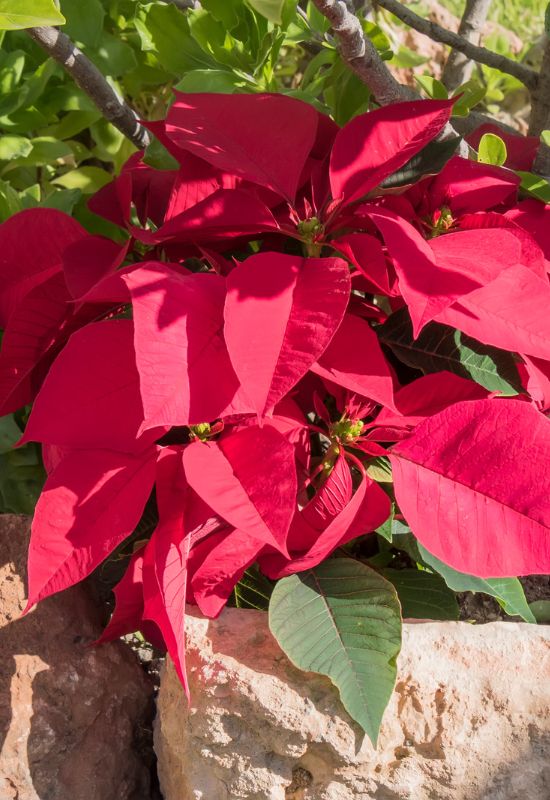
Here we come to a cultivar with a spiky, somewhat sharp look: ‘Holly Berry’. This poinsettia keeps the bright and vibrant scarlet coloring of her mother in the bracts that it grows at its top.
However, it adds a very unusual quality with their shape. They present deep lobes that form lots of pointed margins, and in fact, they may look like those of hollies (hence the name).
For this reason, it is a really ideal variety to decorate homes during the Christmas season, and the little flowers are yellow and red, quite glossy, again, following the same theme.
The foliage lower down the plant is reduced to a few leaves, and they are bright to mid green, with a similar morphology to the modified ones, and adding to the luminosity of this Euphorbia pulcherrima.
10: ‘Pink Champagne’ Poinsettia (Euphorbiapulcherrima ‘Pink Champagne’)
Soft and suave, ‘Pink Champagne’ turns the celebratory theme of poinsettias to a refined, sophisticated and brightly sparkling affair… In fact, the bracts play with a range of pink tonalities, from pale and pastel, even fading to almost white, which offers you the base and overall effect, but blushing to rosy tints in some spots.
The central florets add luminosity with touches of lime (and some red), while some green can creep up from the lower foliage. This also has a palette, rather than a fully decided color, with rare shades of hunter and Castleton.
The foliage is mainly lance shaped, but broad; however, you can expect some lobes, mainly gentle, that offer yet more variation in the ethereal personality of this cultivar.
11: ‘Alaska ‘ Poinsettia (Euphorbiapulcherrima ‘Alaska’)
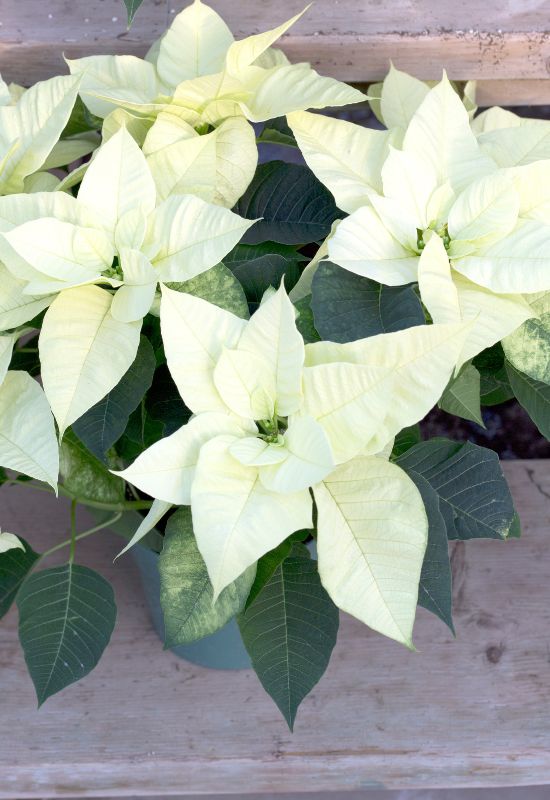
The icy queen of Euphorbia pulcherrima cultivars has a very cold name indeed, ‘Alaska’, and for good reason. As you may have guessed, the tuft of bracts at the top is white, and it can be pure snow to ivory or cream in tonality, probably due to light conditions.
These are usually arranged on two rows, quite regularly so with this poinsettia variety, and they frame the little pea green flowers with their luminosity and candor.
But the biting climate of the US state it is named after is also symbolically and emotionally expressed by the shape of the foliage, with loves that almost appear as cuts, and consequent pointed, sharp looking margins.
The unmodified leaves are lush, green but sometimes with dark purple overtones, and they create a striking bouquet effect with their contrasting shade.
12: ‘Robyn Pink’ Poinsettia (Euphorbiapulcherrima ‘Robyn Pink’)
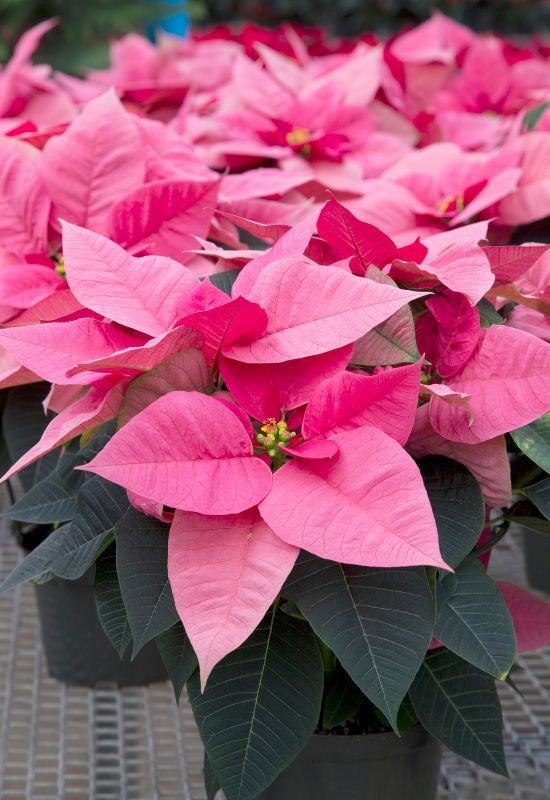
Still festive, but more suitable to a hen party is the shockingly bold and bright ‘Robyn Pink’ poinsettia. In fact, you will need sunglasses to look at the crown of bracts at the top of this cultivar, because their bright rose to magenta color is so strong and vibrant that it may be dangerous for your eyesight!
A lovely contrast with the pale yellowish greenish little flowers, they actually have another twist… The very top modified leaves are smaller in size than the others – an original and decorative touch!
Yet another amazing quality of this variety with a bubblegum personality is the regularity of the lance shaped foliage – it is incredibly reliable at that! Finally, look lower down and you will see a lovely leafy base of dark (basil to hunter) green luxury!
13: ‘Autumn Leaves’ Poinsettia (Euphorbiapulcherrima ‘Autumn Leaves’)
We change season, from festive to melancholic fall, where sunlight fades and gives us a glow of delicate, mellow feelings, as does ‘Autumn Leaves’ poinsettia!
In fact, the bracts of this variety offer you an incredible palette of almost intangible shades, mixing and fusing seamlessly and with great elegance.
There, at the top of your houseplant, you will see a ballet of salmon, peach, coral, touches of sandstone and honey, in a wonderful duet of soft pink and orange tonalities!
Brightening up in the central flowers with yellow and red, the bracts have a very regular, broad and pointed lance shape, almost heart shaped, which is preserved in the foliage underneath.
And here you will find the perfect backdrop for this display: really dark, almost tenebrous green that harkens to the color of night itself, black!
14: ‘Orange Spice’ Poinsettia (Euphorbiapulcherrima ‘Orange Spice’)
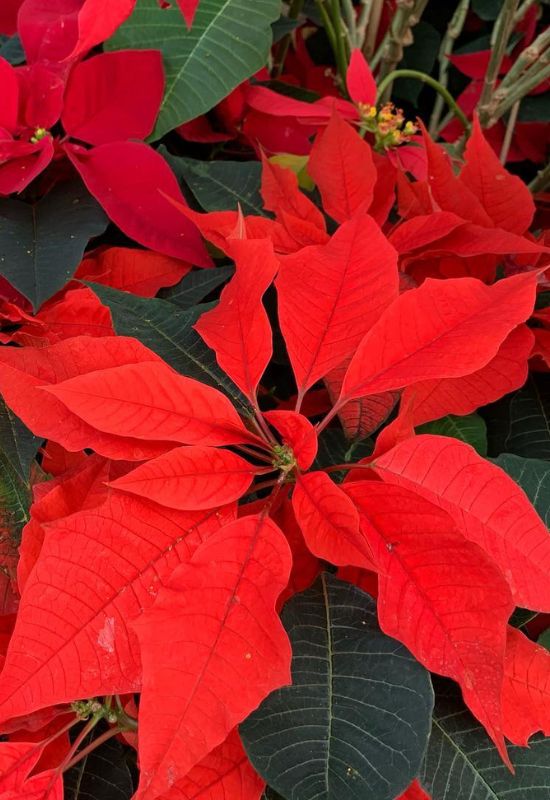
I actually think that ‘Orange Spice’ is one of the most striking cultivars of poinsettia ever! Let me tell you why… To start with it hits an amazing note of fire orange, very bright deep, on the scarlet scale, that almost reaches the red range, only to stop short of it!
The vibrancy and luminosity of this spectacle is doubled by the fact that the bracts are so lush and numerous that they almost cover the whole plant! But there is more… The velvet textured foliage of this variety has a drooping habit, forming a round mound of apparently trailing leafy energy that drapes containers… What is more, the foliage is lobed, and often diamond shaped, with wing like flaps at the sides… When it tries to turn green, at the very base, it often turns purplish, adding depth to thispowerful spectacle. The tiny but glossy florets at the top in bright green, yellow and red put the final touch.
15: ‘Polar Bear’ Poinsettia (Euphorbia pulcherrima ‘Polar Bear’)
In the season of snow coated fields and trees, ‘Polar Bear’ is the white poinsettia that best fits a picture postcard scene… The name is not random, because its color is really like that of the North Pole plains, and its texture like that of the big mammals that inhabit those regions… And very much so, because the distinctive characteristics of thus small cultivar is the the candid bracts cover the plant almost completely!
These are balanced and lance shaped, and then… When they attempt the transition to the deep green, unmodified foliage, you will see very decorative hybrid leaves with an ivory colored surface and green mid rib and veins, in a fishbone pattern.
This decorative quality is intriguing and perfect for a luminous indoor space, making it the “albino” member of this leafy family, like a little white cub, with tiny flowers at the top, green with a drop of yellow.
16: ‘Strawberries and Cream’ Poinsettia (Euphorbia pulcherrima ‘Strawberries and Cream’)
On to another, really surprising variegated poinsettia, meet ‘Strawberries and Cream’! This variety of Euphorbia pulcherrima, has a very distinctive look, and it is not just due to its coloring.
But we can start with this… The bracts take on shades of pink, on the rose side but pastel rather than vibrant at most, and these are mixed with irregular patches of cream white… However, it is also their particular shape that sets it apart from other cultivars…
The new foliage at the top is irregularly but softly lobed, but as it matures, the lobes deepen, forming teeth, horns, pointed protrusions at the margins.
The texture it provides is intriguing if unruly, and maybe for this reason, it is one of the best garden varieties. Look lower down and you will also see that the unmodified leaves are of a bright green shade, on the moss to India range.
17: ‘Winter Rose Dark Red’ Poinsettia (Euphorbia pulcherrima ‘Winter Rose Dark Red’)
Now, ‘Winter Rose Dark Red’ is a poinsettia cultivar that brings in a new dimension to thus genus of popular Christmastime houseplants… The color, well, you guessed that it is red, however, we need to be more specific… Some specimens will develop the typically bright scarlet tonality we find in classic varieties, but others will give you a crimson, even raspberry note!
But this is not its main innovation… The bracts are not flat! No, in fact they furl and twist, forming waves and hill shaped on the surface, and they stick closely packed together at the top.
For this reason, it looks like a flower, I am not sure if a rose, rather maybe a dahlia, but still, the effect is very eye catching indeed!
On the contrary the rest of the foliage is ovate, broad, only gently arching, with regular veins in a fishbone pattern and very, very dark green almost tan!
18: ‘Jingle Bell Rock’ Poinsettia (Euphorbia pulcherrima ‘Jingle Bell Rock’)
I suppose that ‘Jingle Bell’ rock has some of the best and most striking variegation of all poinsettia cultivars… In fact, the bracts at the top form star shaped rosettes with a large central patch of cream butter yellow, very pale and quite luminous, but also soft, mellow, sweet…
This then becomes drops and dashes of red, on the ruby side, which then condense together to form an irregular but continuous splash especially around the margins.
The shape of the foliage is pointed, fairly long, and from lance to diamond shaped, with a few lobes, but not many. This is preserved in the unmodified leaves, which are quite a few and lush, dark green approaching tan, and thanks to them to display of colors around the little blooms is set off really clearly indeed!
19: ‘Winter Rose White’ Poinsettia (Euphorbia pulcherrima ‘Winter Rose White’)
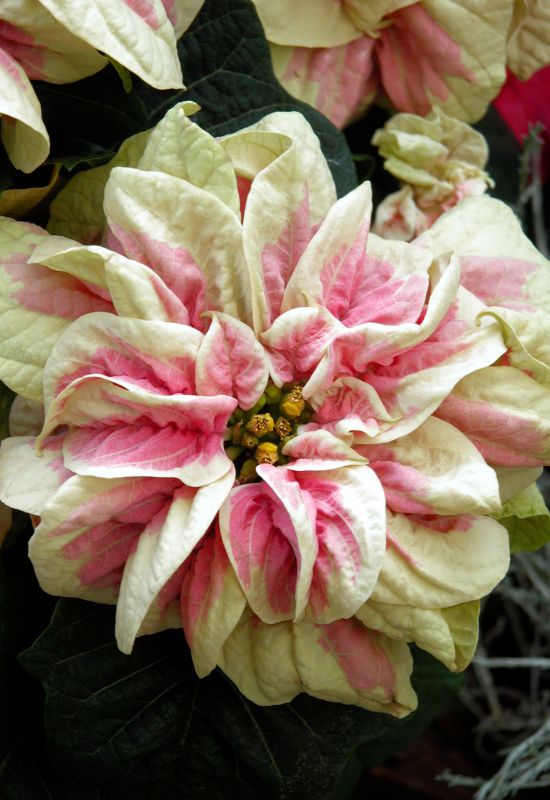
A twin to ‘Winter Rose Red’, ‘Winter Rose White’, of course, is the sister with the color of snow, or rather ivory, sometimes with a pink cream glow… It will form a dense rosette of sinuously folding, lushly soft and gently twisting bracts of different sized at the top that looks a big like a meringue…
The little blooms in the middle add a focal point when they are bright green and in bud, only to become even more vibrant when they open with yellow and red energy!
The rest of the very generous foliage keeps the lanceolate (lance) shape, but it brings it to depth of green that touch the Castleton, but not necessarily, as this depends on their age and on light conditions. Nevertheless, the contrast is just perfect to set off the flower like display at the top.
20: ‘Ice Punch’ Poinsettia (Euphorbiapulcherrima ‘Ice Punch’)
Aptly named ‘Ice Punch’ is one of the most colorful poinsettia varieties you can ever grow. The bracts are quite large, forming rosettes that display a very vibrant palette indeed! In fact, you will see patches of many shades and on the scale from red to white.
The mixing of the two colors happens in steps, with crimson being the most frequent on one end of the scale, though scarlet is not uncommon as well.
In between, rose, magenta and pink form transition dashes, till we move into the realm of snow, mainly in ivory… The effect is heightened when the little blooms open with drops of yellow, bright green and red.
Consistently lance shaped, the foliage, then turns deep green, sometimes “importing” some white variegation into the unmodified leaves. The overall effect is quite striking and energetic, sharp, a bit sour, but very decorative.
21: ‘Prestige Maroon’ Poinsettia (Euphorbiapulcherrima ‘Prestige Maroon’)
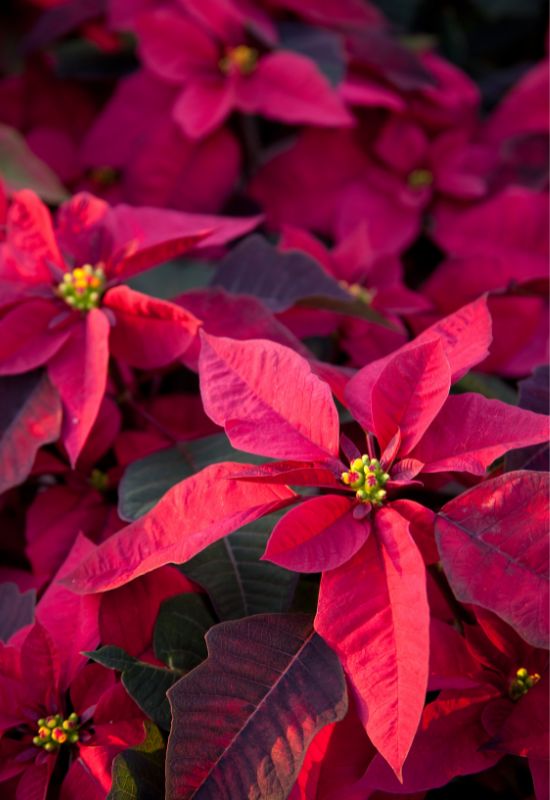
‘Prestige Maroon’ is a poinsettia variety with an elegance of its own… The bracts have a a very lustrous and plush shade of magenta, which in itself makes it very luxurious looking.
The cluster of flowers in the middle is very small, which gives predominance to the foliage, and this (including the bracts) has a very unusual shape… The leaves start off narrow and then widen, with lobes that give them an irregular but eye catching style, harmonious but creative at the same time.
This also affects the habit of this plant, which, unlike most Euphorbia pulcherrima cultivars, is quite open and airy… Then, the color turns to an impressive dark hunter green, for a perfect chromatic combination. It is definitely a poinsettia for elegant, even important rooms, with a deep and authoritative personality.
22: ‘Cinnamon Star’ Poinsettia (Euphorbiapulcherrima ‘Cinnamon Star’)
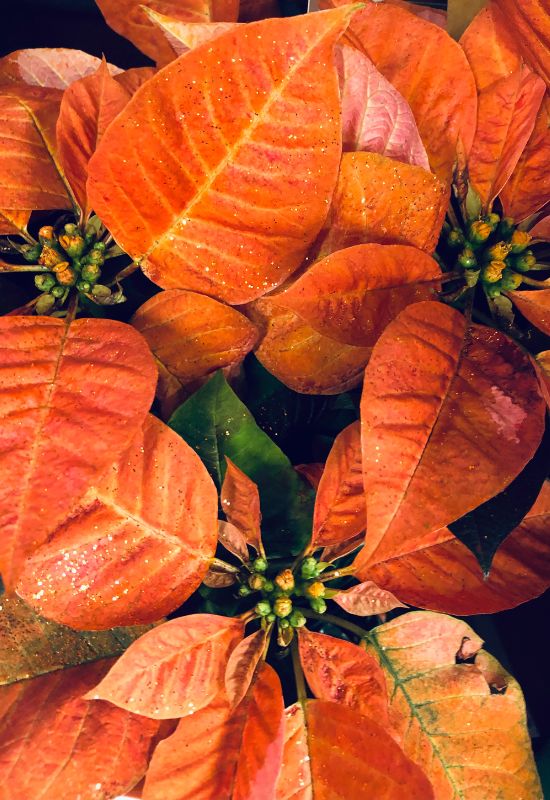
‘Cinnamon Star’ is a very popular variety of Euphorbia pulcherrima, and there must be a good reason for this; let’s try to find out… Maybe the main reason why many people love it as a houseplant is the coloring of its bracts… In fact, they are pink, but it is not as simple as that… The many pastel tonalities that paint them include sift shades of shell, sand, coral and even salmon.
What is more, they mix seamlessly, as if finely dusted on a canvas… But this is a very surprising cultivar, because with light, it can blush into the orange and yellow range! Then, you will see apricot, sandstone and saffron creep in as well.
Then again, all the foliage is quite regularly lance shaped and pointed, though smaller at the top, where the cluster of tiny yellow flowers, on the dark side, more mustard than gold, gives a gentle injection of energy.
The unmodified leaves take on a minor, almost backstage role, forming a dark pine green frame, or base to one of the most refined color spectacles you can ever have indoors.
23: ‘Red Elf’ Poinsettia (Euphorbia pulcherrima ‘Red Elf’)
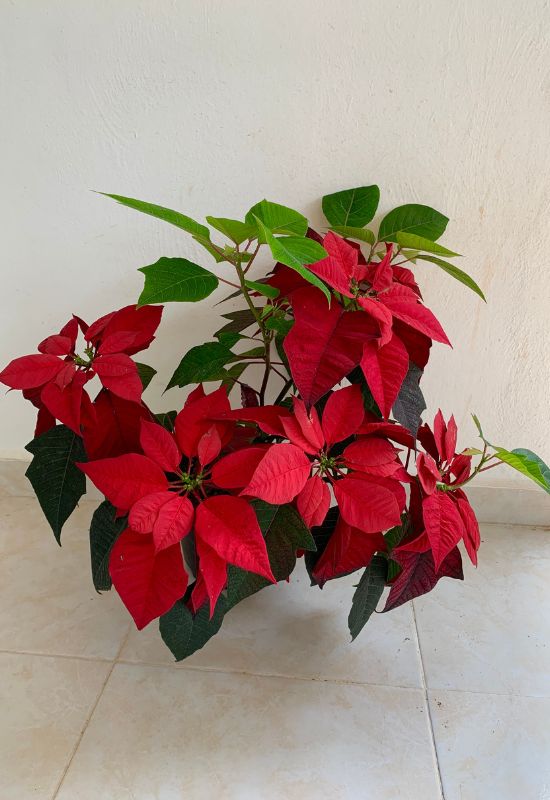
And we come to a little, but super energetic cultivar of Euphorbia pulcherrima: ‘Red Elf’. What this variety of poinsettia lacks in size, it makes up in personality! The fact is that its bracts are of the most vibrant, luminous and powerful scarlet red ever!
However, I have seen some specimen take up crimson tonalities as well, but always bright. Anyway, the “other fact” is that they take up most of the plant itself, leaving the unmodified leaves to make a little rich green wreath at the base.
This gives it a decided bouquet like appearance, but… Not a romantic one, but a very fiery, even rebellious display at that!
Yes, because the leaf shape is quite unruly, playing with the diamond and lanceolate prototypes and adding lobes to give you the impression that your little houseplant has actually caught fire! It is an ideal choice for a focal point during the festive season!
24: ‘Freedom Marble’ Poinsettia (Euphorbia pulcherrima ‘Freedom Marble’)
‘Freedom Marble’ deserves a very special place indeed among poinsettia varieties… In fact, this cultivar hits a balance of colors that makes it stand out… You will see that the bracts seem to be painted by the delicate hand of a luminous soul with lots to express…
Yes, because they are mainly soft pink, on the shell side (though, as usual, light can affect it). But dashes of bright rose appear in the middle, freely and with flair, like feathers of passion on a romantic backdrop!
Charming and really speaking to your heart, they also have a very consistent, broad and lance shape, with a clear tip and a soft texture to boot! The foliage turns green lower down, but there you may also see some variegation with white, for an extra touch of of elegant beauty.
25: ‘Early Monet’ Poinsettia (Euphorbia pulcherrima ‘Early Monet’)
We have seen that Euphorbia pulcherrima is more of a painter than a houseplant… And it is only fair to close this journey with a cultivar dedicated to one of the most amazing artists in history: ‘Early Monet’!
And yes, like the French Master, this poinsettia has an Impressionist brushstroke! Arguably one of the most beautiful and popular novelty varieties, it has a rosette of bracts with a palette to tale your breath away… Of course, true to the artistic movement it is named after, lots depends on light.
But you can expect the most vibrant as well as delicate shades all the way from red to almost yellow!
Mixing and fusing to create new colors, you will see them create sunsets when the scarlet takes over, and dawns with hints of pink when when crimson prevails… Orange is, of course, on the menu as well, with this miraculous plant.
The foliage is all broad and lance shaped, with the odd lobe, and it turns green, on the dark emerald side, only at the very base.
‘Early Monet’ is actually part of a series, which includes ‘Monet Twilight’ as well, which hits notes along the scale of crimson to pale pink.
Poinsettia Varieties: The Masters of Colors for the Festive Season and Beyond!
And here we come to the end… There are really few houseplants that dress your indoor spaces for the festiveseason like poinsettias do – actually, maybe none at all! But with all the colors that its many cultivars offer, and all the many leaf shapes, are you sure you still want to think of Euphorbia pulcherrima only as a Christmas plant?

Written By
Amber Noyes
Amber Noyes was born and raised in a suburban California town, San Mateo. She holds a master’s degree in horticulture from the University of California as well as a BS in Biology from the University of San Francisco. With experience working on an organic farm, water conservation research, farmers’ markets, and plant nursery, she understands what makes plants thrive and how we can better understand the connection between microclimate and plant health. When she’s not on the land, Amber loves informing people of new ideas/things related to gardening, especially organic gardening, houseplants, and growing plants in a small space.

